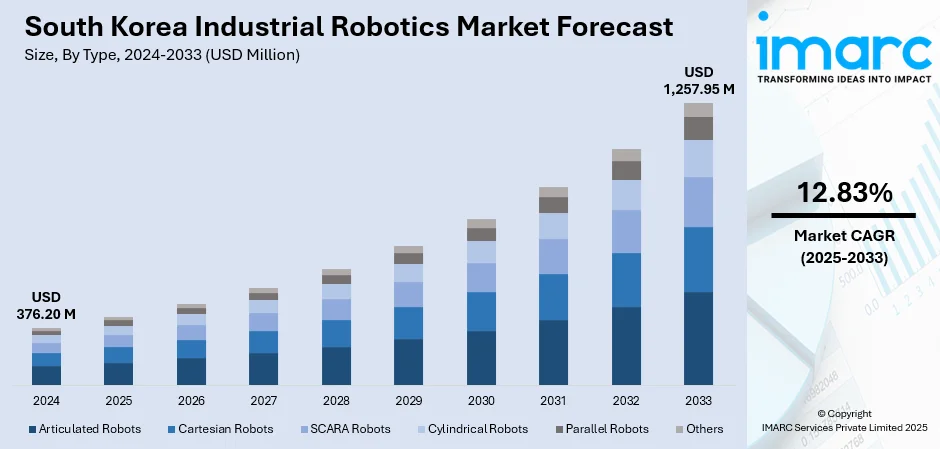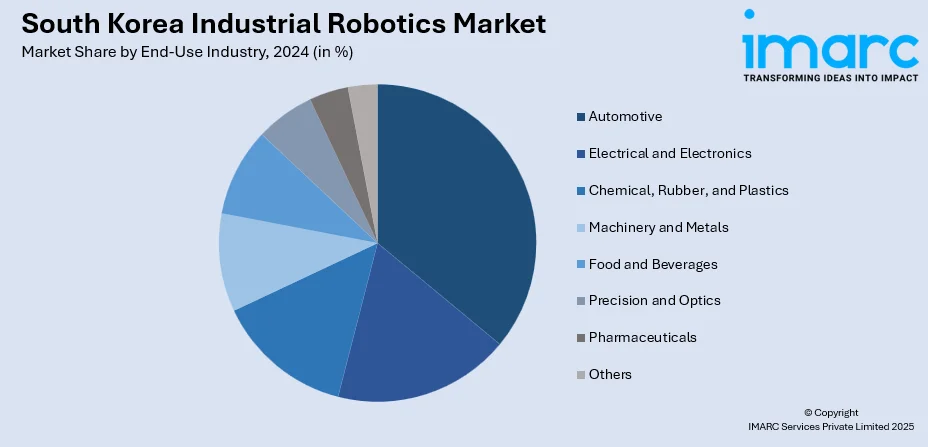
South Korea Industrial Robotics Market Size, Share, Trends and Forecast by Type, Function, End-Use Industry, and Region, 2025-2033
South Korea Industrial Robotics Market Overview:
The South Korea industrial robotics market size reached USD 376.20 Million in 20244. Looking forward, the market is expected to reach USD 1,257.95 Million by 2033, exhibiting a growth rate (CAGR) of 12.83% during 2025-2033. The market is rapidly advancing, driven by world‑leading robot density, extensive automation in manufacturing and electronics, and strong government backing through R&D funding and smart factory initiatives. The rise of collaborative robots and Industry 4.0 adoption also enhances operational efficiency and precision. These forces are propelling the South Korea industrial robotics market share.
|
Report Attribute
|
Key Statistics
|
|---|---|
|
Base Year
|
2024 |
|
Forecast Years
|
2025-2033
|
|
Historical Years
|
2019-2024
|
| Market Size in 2024 | USD 376.20 Million |
| Market Forecast in 2033 | USD 1,257.95 Million |
| Market Growth Rate 2025-2033 | 12.83% |
South Korea Industrial Robotics Market Trends:
High Automation Demand in Electronics and Automotive Industries
South Korea's industrial robotics market is significantly driven by the country’s highly automated electronics and automotive sectors. Major players such as Samsung, Hyundai, and LG rely heavily on automation using robotics to improve accuracy, speed, and efficiency in production. As competition from around the globe grows, manufacturers are turning to robots for improved productivity, lower error rates, and reduced labor costs. The need for robots that can conduct micro-assembly, PCB production, welding, and painting keeps increasing. These industries also need robots that can be used in cleanrooms, particularly in semiconductor production. With increasing product complexity and enhanced quality requirements, industrial robots become more important to satisfy output targets and ensure South Korea's competitiveness in international electronics and automotive supply chains.

To get more information on this market, Request Sample
Strong Government Support and Smart Factory Initiatives
Government initiatives play a central role in accelerating robotics adoption, thus boosting the South Korea industrial robotics market growth. Through programs such as the "Smart Factory Initiative," the government provides financial subsidies, research and development (R&D) funding, and tax incentives to small and medium-sized enterprises (SMEs) implementing robotic solutions. The Ministry of Trade, Industry and Energy (MOTIE) has set ambitious targets to transform thousands of factories into smart production units powered by AI, robotics, and IoT. These initiatives not only foster innovation but also improve industrial efficiency and competitiveness. By easing the cost barrier for robotics integration, especially for SMEs, the government is helping expand the application of industrial robots beyond large corporations, making automation more accessible and widespread across the manufacturing landscape.
Advancements in Collaborative and AI-Powered Robotics
Technological advancements in collaborative robots (cobots) and AI-powered systems are revolutionizing South Korea’s industrial robotics market. Cobots are increasingly being used alongside human workers for tasks such as assembly, packaging, and quality inspection due to their flexibility and safety features. These robots are ideal for SMEs with limited space and resources. Additionally, the integration of artificial intelligence and machine learning allows robots to adapt, self-optimize, and handle more complex, variable production tasks. This evolution reduces downtime, enhances product quality, and increases operational efficiency. As South Korea pushes forward with its Industry 4.0 agenda, the growing sophistication of intelligent robotics is transforming conventional manufacturing into agile, data-driven, and automated operations across various sectors.
South Korea Industrial Robotics Market Segmentation:
IMARC Group provides an analysis of the key trends in each segment of the market, along with forecasts at the country and regional levels for 2025-2033. Our report has categorized the market based on type, function, and end-use industry.
Type Insights:
- Articulated Robots
- Cartesian Robots
- SCARA Robots
- Cylindrical Robots
- Parallel Robots
- Others
The report has provided a detailed breakup and analysis of the market based on the type. This includes articulated robots, cartesian robots, SCARA robots, cylindrical robots, parallel robots, and others.
Function Insights:
- Soldering and Welding
- Materials Handling
- Assembling and Disassembling
- Painting and Dispensing
- Milling, Cutting and Processing
- Others
A detailed breakup and analysis of the market based on the function have also been provided in the report. This includes soldering and welding, materials handling, assembling and disassembling, painting and dispensing, milling, cutting and processing, and others.
End-Use Industry Insights:

- Automotive
- Electrical and Electronics
- Chemical, Rubber, and Plastics
- Machinery and Metals
- Food and Beverages
- Precision and Optics
- Pharmaceuticals
- Others
The report has provided a detailed breakup and analysis of the market based on the end-use industry. This includes automotive, electrical and electronics, chemical, rubber, and plastics, machinery and metals, food and beverages, precision and optics, pharmaceuticals, and others.
Regional Insights:
- Seoul Capital Area
- Yeongnam (Southeastern Region)
- Honam (Southwestern Region)
- Hoseo (Central Region)
- Others
The report has also provided a comprehensive analysis of all the major regional markets, which include Seoul Capital Area, Yeongnam (Southeastern Region), Honam (Southwestern Region), Hoseo (Central Region), and others.
Competitive Landscape:
The market research report has also provided a comprehensive analysis of the competitive landscape. Competitive analysis such as market structure, key player positioning, top winning strategies, competitive dashboard, and company evaluation quadrant has been covered in the report. Also, detailed profiles of all major companies have been provided.
South Korea Industrial Robotics Market News:
- In July 2024, Hyundai Motor Company and Kia Corporation officially launched their industrial wearable robot, the X-ble Shoulder, in South Korea by delivering the inaugural unit to Korean Air at a ceremonial handover event. This introduction marks the robot’s formal entry into the domestic market, highlighting its role in enhancing workplace efficiency and ergonomics. The launch event took place at Korean Air’s aircraft maintenance hangar located in Incheon.
- In February 2025, Daedong, led by co-CEOs Kim Jun-Sik and Won Yu-Hyun, officially unveiled its latest agricultural transport robot, the “RT100,” during the “2025 Daedong Convention Korea.” The RT100 is available in two variants: a wire-guided version and an autonomous model. Designed to reduce manual labor, both models offer user-friendly operation on an electric platform, featuring a range of practical transport capabilities.
South Korea Industrial Robotics Market Report Coverage:
| Report Features | Details |
|---|---|
| Base Year of the Analysis | 2024 |
| Historical Period | 2019-2024 |
| Forecast Period | 2025-2033 |
| Units | Million USD |
| Scope of the Report |
Exploration of Historical Trends and Market Outlook, Industry Catalysts and Challenges, Segment-Wise Historical and Future Market Assessment:
|
| Types Covered | Articulated Robots, Cartesian Robots, SCARA Robots, Cylindrical Robots, Parallel Robots, Others |
| Functions Covered | Soldering and Welding, Materials Handling, Assembling and Disassembling, Painting and Dispensing, Milling, Cutting and Processing, Others |
| End-Use Industries Covered | Automotive, Electrical and Electronics, Chemical, Rubber, and Plastics, Machinery and Metals, Food and Beverages, Precision and Optics, Pharmaceuticals, Others |
| Regions Covered | Seoul Capital Area, Yeongnam (Southeastern Region), Honam (Southwestern Region), Hoseo (Central Region), Others |
| Customization Scope | 10% Free Customization |
| Post-Sale Analyst Support | 10-12 Weeks |
| Delivery Format | PDF and Excel through Email (We can also provide the editable version of the report in PPT/Word format on special request) |
Key Questions Answered in This Report:
- How has the South Korea industrial robotics market performed so far and how will it perform in the coming years?
- What is the breakup of the South Korea industrial robotics market on the basis of type?
- What is the breakup of the South Korea industrial robotics market on the basis of function?
- What is the breakup of the South Korea industrial robotics market on the basis of end-use industry?
- What is the breakup of the South Korea industrial robotics market on the basis of region?
- What are the various stages in the value chain of the South Korea industrial robotics market?
- What are the key driving factors and challenges in the South Korea industrial robotics market?
- What is the structure of the South Korea industrial robotics market and who are the key players?
- What is the degree of competition in the South Korea industrial robotics market?
Key Benefits for Stakeholders:
- IMARC’s industry report offers a comprehensive quantitative analysis of various market segments, historical and current market trends, market forecasts, and dynamics of the South Korea industrial robotics market from 2019-2033.
- The research report provides the latest information on the market drivers, challenges, and opportunities in the South Korea industrial robotics market.
- Porter's five forces analysis assist stakeholders in assessing the impact of new entrants, competitive rivalry, supplier power, buyer power, and the threat of substitution. It helps stakeholders to analyze the level of competition within the South Korea industrial robotics industry and its attractiveness.
- Competitive landscape allows stakeholders to understand their competitive environment and provides an insight into the current positions of key players in the market.
Need more help?
- Speak to our experienced analysts for insights on the current market scenarios.
- Include additional segments and countries to customize the report as per your requirement.
- Gain an unparalleled competitive advantage in your domain by understanding how to utilize the report and positively impacting your operations and revenue.
- For further assistance, please connect with our analysts.
 Request Customization
Request Customization
 Speak to an Analyst
Speak to an Analyst
 Request Brochure
Request Brochure
 Inquire Before Buying
Inquire Before Buying




.webp)




.webp)












